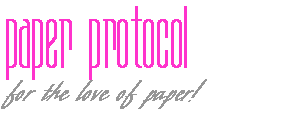Will you Engrave, Blind Emboss, or Thermography your stationery? Perhaps Letterpress printing is more your style? With so many options, choosing which one to use can be daunting. Fear not, see below for the ins and outs of some of the more Common Printing Techniques. I suggest sitting down with a local Experienced Stationery Retailer to get a true feel (literally, you want to feel the weight of the paper and appreciate the differences). They can also help walk you through which items are best suited for the different techniques!
Flat
Technically known as Offset/Lithography and is recognized by clean edges and smooth print.
Thermography
Freshly printed inks are dusted with a powder compound. After the excess powder on the non-printing areas is removed by vacuum, the sheet passes under a heater, which fuses the ink and powdered compound. The printing swells or raises to simulate the look of engraving, but shiny.
Engraving
Letters and designs are cut or etched into a copper plate. The plate is inked so that all sub-surfaces are filled with ink, then the surface is wiped clean, leaving ink only in the depressed (or sunken) areas of the plate. The paper is forced against the plate with tremendous pressure, drawing the ink from the depressed areas. This produces the characteristic indented or bruised impression on the back of the paper.
Blind Embossing
Similar to the Engraving process, but without ink. The plate is pressed into the paper creating a raised look to the text or design.
Letterpress--My Personal Fave!
The oldest and most versatile method of printing was originally produced from cast metal type or plates on which the image or printing areas are raised above the non-printing areas of the plate. Ink touches only the top surface of the raised areas; the surrounding (non-printing) areas are lower and do not receive ink. The inked image is transferred directly into the paper. Sometimes a slight embossing (because of denting) appears on the reverse side of the paper. The letterpress image is usually sharp and crisp. A heavier, more substantial paper is typically used.
What are you waiting for? Get out there and get in touch with paper!
Monday, October 6, 2008
Printing Process Primer
Subscribe to:
Post Comments (Atom)

1 comment:
I agree, letterpress is beautiful! It seems so "nice" because the weight of the paper is so substantial. Thanks for the primer on the different styles.
Post a Comment